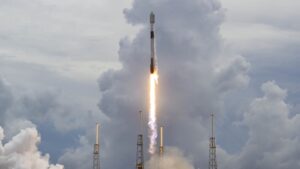It will be used again when the CRS-22 cargo Dragon spacecraft splashes down off the Florida cost late July 9.
SDI, under development by the FAA for several years, automates the transfer of data about launches and reentries to air traffic controllers so they have up-to-date information on the progress of those activities, including any anomalies that might create debris or other aviation hazards. That can allow controllers to more efficiently manage air traffic around those closures.
“The overall impact and the benefit is reducing the amount of time it takes to close or reopen airspace,” Tim Arel, deputy chief operating officer of the FAA’s Air Traffic Organization, said of the SDI in a call with reporters.
The intent is to allow quicker reopening of airspace once a launch or reentry has safely transited airspace. “We’re able to more dynamically adjust those closures,” he said. “What it means is that those flights moved out of the way to accommodate a safe operation of that space mission will be able to more quickly get back on to their normal flight path, or maybe even get some shortcuts.”
Arel said that other measures it had been taking for airspace closures already reduced the average length from more than four hours to more than two hours. “We know SDI will help us open the airspace even quicker,” he said, but didn’t offer an estimate of how much of an improvement it will provide.
The growing cadence of commercial launches in recent years — there have been 33 licensed launches so far in 2021, compared to 11 in all of 2016 — prompted pushback from the aviation industry given the conventional approach to closing large amounts of airspace for each launch. A breaking point was the first Falcon Heavy launch in February 2018 that closed airspace off the Florida coast for hours on a weekday afternoon, affecting hundreds of flights in a busy corridor.
The aviation and commercial spaceflight industries have been working together more closely together since then, including pushing for tools like SDI that have the potential to reduce the size and duration of airspace closures. However, the long development cycle for SDI prompted congressional criticism at a June 16 hearing of the House Transportation Committee’s aviation subcommittee.
At the hearing, Rep. Peter DeFazio (D-Ore.), chair of the full committee, pressed the FAA on the slow progress on SDI, stating he was opposed to delaying airline flights “because some millionaire or billionaire is going to experience 15 minutes of weightlessness.”
At the hearing, Wayne Monteith, associate administrator for commercial space transportation at the FAA, said operational tests of SDI would begin soon, although there wasn’t a timeline for full integration of SDI. Work on it has accelerated, he said, since the project was handed over to Teri Bristol, chief operating officer of the FAA’s Air Traffic Organization (ATO).
“We have seen tremendous, tremendous progress in just the last two years as Teri Bristol and the ATO has taken this responsibility on with our technical help,” he said in the call with reporters.
Currently, participation in the SDI is voluntary. Besides SpaceX, which started cooperating with the FAA on the SDI in 2016, others include Blue Origin, Firefly Aerospace and Alaska Aerospace Corporation, which operates the launch site on Kodiak Island, Alaska. Monteith didn’t give a schedule for bringing other companies into the system, but emphasized the importance of having an automated system like SDI to improve safety.
There are limits, though, to what tools like SDI can do to improve management of launches in the National Airspace System. On June 29, the first Transporter-2 launch attempt was scrubbed shortly after a helicopter entered restricted airspace near the pad, halting the countdown seconds before liftoff. “Unfortunately, launch is called off for today, as an aircraft entered the ‘keep out zone’, which is unreasonably gigantic,” Elon Musk, chief executive of SpaceX, tweeted shortly after the scrub. “There is simply no way that humanity can become a spacefaring civilization without major regulatory reform. The current regulatory system is broken.”
Arel said that SDI did not play a factor in the Transporter-2 scrub, since the airspace violation took place before launch. “It was ready to be used for the first attempt and was not needed,” he said.



